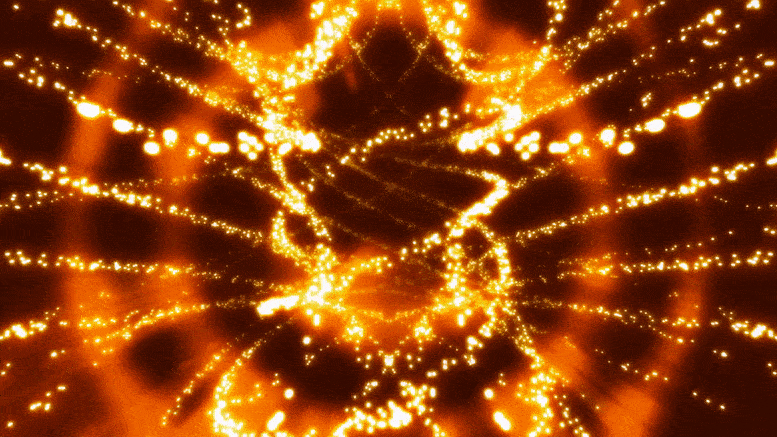Un métamatériau innovant aux propriétés non conventionnelles utilise des signaux électriques pour contrôler la direction et l’intensité des ondes d’énergie traversant un solide. Ce métamatériau innovant, qui a une densité de masse unique, s’écarte de la deuxième loi de Newton, en ce sens que la force et l’accélération ne vont pas dans le même sens. Huang envisage un large éventail d’applications allant des utilisations militaires et commerciales, telles que le contrôle des ondes radar ou la gestion des vibrations de la turbulence de l’air dans les avions, aux utilisations civiles telles que la surveillance de la santé des structures telles que les ponts et les pipelines.
Des chercheurs de l’Université du Missouri ont conçu un prototype d’un petit métamatériau énergétique léger qui peut contrôler la direction et l’intensité des ondes d’énergie.
Le professeur Guoliang Huang de l’Université du Missouri a développé un prototype de métamatériau capable de contrôler la direction et l’intensité des ondes d’énergie à l’aide de signaux électriques. Le matériau innovant a des applications potentielles dans les secteurs militaire et commercial, et peut également être utilisé pour surveiller la santé structurelle des ponts et des pipelines.
Depuis plus de 10 ans, Guoliang Huang, titulaire de la chaire Huber et Helen Croft en ingénierie à l’Université du Missouri, étudie les propriétés non conventionnelles de « [{ » attribute= » »>metamaterials” — an artificial material that exhibits properties not commonly found in nature as defined by Newton’s laws of motion — in his long-term pursuit of designing an ideal metamaterial.
Huang’s goal is to help control the “elastic” energy waves traveling through larger structures — such as an aircraft — without light and small “metastructures.”

The prototype metamaterial uses electrical signals transported by these black wires to control both the direction and intensity of energy waves passing through a solid material. Credit: University of Missouri
“For many years I’ve been working on the challenge of how to use mathematical mechanics to solve engineering problems,” Huang said. “Conventional methods have many limitations, including size and weight. So, I’ve been exploring how we can find an alternative solution using a lightweight material that’s small but can still control the low-frequency vibration coming from a larger structure, like an aircraft.”

Guoliang Huang. Credit: University of Missouri
Now, Huang’s one step closer to his goal. In a new study published in the Proceedings of the National Academy of Sciences (PNAS) on May 18, Huang and colleagues have developed a prototype metamaterial that uses electrical signals to control both the direction and intensity of energy waves passing through a solid material.
Potential applications of his innovative design include military and commercial uses, such as controlling radar waves by directing them to scan a specific area for objects or managing vibration created by air turbulence from an aircraft in flight.
“This metamaterial has odd mass density,” Huang said. “So, the force and acceleration are not going in the same direction, thereby providing us with an unconventional way to customize the design of an object’s structural dynamics, or properties to challenge Newton’s second law.”
This is the first physical realization of odd mass density, Huang said.
“For instance, this metamaterial could be beneficial to monitor the health of civil structures such as bridges and pipelines as active transducers by helping identify any potential damage that might be hard to see with the human eye.”
Reference: “Active metamaterials for realizing odd mass density” by Qian Wu, Xianchen Xu, Honghua Qian, Shaoyun Wang, Rui Zhu, Zheng Yan, Hongbin Ma, Yangyang Chen and Guoliang Huang, 18 May 2023, Proceedings of the National Academy of Sciences.
DOI: 10.1073/pnas.2209829120
Other MU contributors include Qian Wu, Xianchen Xu, Honghua Qian, Shaoyun Wang, Zheng Yan and Hongbin Ma. Grants from the Air Force Office of Scientific Research and the Army Research Office funded the research.

« Évangéliste généraliste de la bière. Pionnier du café depuis toujours. Défenseur certifié de Twitter. Internetaholic. Praticien du voyage. »






More Stories
Des scientifiques de Cambridge dévoilent une nouvelle théorie sur les origines des éléments constitutifs de la vie
Hubble célèbre son 34e anniversaire avec une vue imprenable sur la nébuleuse du Petit Haltère
Avertissement urgent pour une femme de 23 ans paralysée par des restes de soupe